
|
You entered: all sky
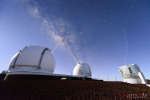 Four Lasers over Mauna Kea
Four Lasers over Mauna Kea
23.06.2014
Are lasers from giant telescopes being used to attack the Galactic center? No. Lasers shot from telescopes are now commonly used to help increase the accuracy of astronomical observations. In some sky locations, Earth...
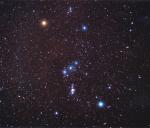 Orion on Film
Orion on Film
6.02.2003
Orion, the Hunter, is one of the most easily recognizable constellations in planet Earth's night sky. But Orion's stars and nebulae don't look quite as colorful to the eye as they do in this lovely photograph, taken last month from Vekol Ranch south of Phoenix, Arizona, USA.
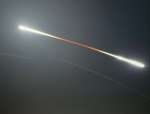 Moon Slide Slim
Moon Slide Slim
19.02.2008
No special filters - or even a telescope - are required to enjoy a leisurely lunar eclipse. In fact, watched from all over the night side of planet Earth, these regular celestial performances have entertained many casual skygazers. Still, this eye-catching picture of a lunar eclipse may look unfamiliar.
 Night Lights
Night Lights
3.11.2010
Constellations of lights sprawl across this night scene, but they don't belong in the skies of planet Earth. Instead, the view looks down from the International Space Station as it passed over the United States along the northern Gulf Coast on October 29. A Russian Soyuz spacecraft is docked in the foreground.
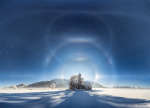 APOD: 2023 December 20 Б Ice Halos over Bavaria
APOD: 2023 December 20 Б Ice Halos over Bavaria
19.12.2023
What's causing those unusual sky arcs? Ice crystals. While crossing a field of fresh snow near Fцssen, Bavaria, Germany, earlier this month, the photographer noticed that he had entered an ice fog.
 A Space Shuttle Over Los Angeles
A Space Shuttle Over Los Angeles
26.09.2012
It's not every day that a space shuttle lands at LAX. Although this was a first for the major Los Angeles airport hub, it was a last for the space shuttle Endeavour, as it completed its tour of California skies and landed, albeit atop a 747, for the last time.
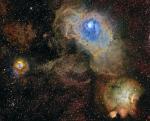 Three Nebulae in Narrow Band
Three Nebulae in Narrow Band
1.11.2007
Narrow band filters and a false-color palette give these three nebulae a stunning appearance against the cosmic canvas of the central Milky Way. All three are stellar nurseries about 5,000 light-years or so distant, toward the nebula rich constellation Sagittarius.
 Tardigrade in Moss
Tardigrade in Moss
6.03.2013
Is this an alien? Probably not, but of all the animals on Earth, the tardigrade might be the best candidate. That's because tardigrades are known to be able to go for decades without...
 Planets Over Egyptian Pyramid
Planets Over Egyptian Pyramid
3.05.2022
The early morning planet parade continues. Visible the world over, the planets Jupiter, Venus, Mars and Saturn have been lining up in the pre-dawn sky since mid-April. In the featured image taken last month, these planets were captured over the Step Pyramid of Djoser, a UNESCO World Heritage Site.
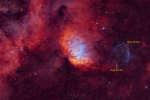 APOD: 2024 August 28 Б Tulip Nebula and Black Hole Cygnus X 1
APOD: 2024 August 28 Б Tulip Nebula and Black Hole Cygnus X 1
27.08.2024
When can you see a black hole, a tulip, and a swan all at once? At night -- if the timing is right, and if your telescope is pointed in the right direction. The complex and beautiful Tulip Nebula blossoms about 8,000 light-years away toward the constellation of Cygnus the Swan.
|
January February March April May June July |
|||||||||||||||||||||||||||||||||||||||||||||||||